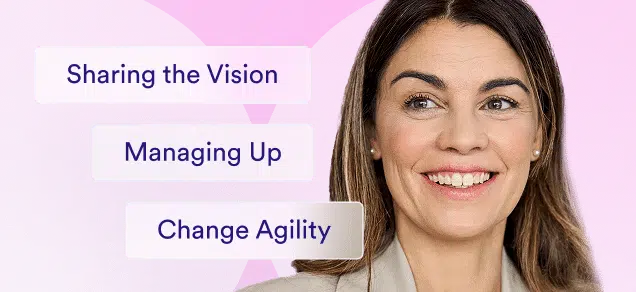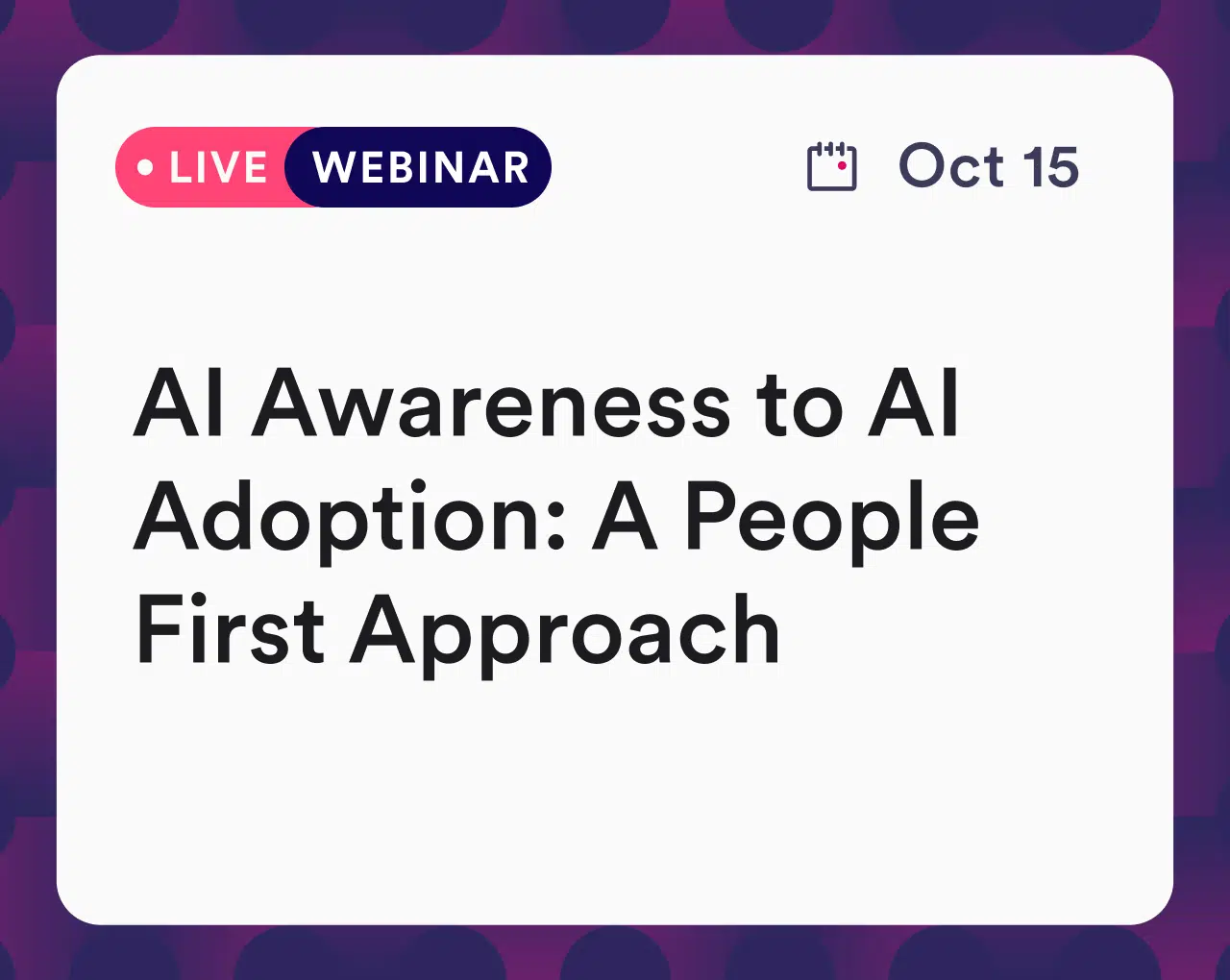Below is a transcript from the recent session at Forward. Prefer to watch the recording? Click here.
Introducing our experts from Hone, Lattice, Plaid and Pando
Rea Rotholz: Welcome to our second session today as part of the Forward conference. We’ll give you just a quick second to get dialed in and settled in. Hopefully, many of you were on our first session with Markus, talking about what’s hype and what’s real.
A couple of people in the chat mentioned they’d love some tactical things that companies are doing in terms of workforce transformation and upskilling in the age of AI. And that’s why we have today’s panel, Upskilling and Performance Reimagined in the AI Era.
I am here with a powerhouse panel of amazing women—super happy to be here with you all. To get started, I’ll quickly introduce myself and then would love to hear from each of you briefly about your role.
I’m Rea Rotholz, and I lead Hone’s Learning Solutions team. I’ll pass it to Barbara if you’d like to do your intro.
Barbara Gago: Hey everyone, thanks for joining us. I’m Barbara Gago, founder and CEO of a company called Pando. We help organizations move beyond the traditional paradigm around performance reviews and build more continuous, equitable performance systems.
Before founding Pando, I was building high-performing teams as a CMO in a hybrid growth startup. So lots of interesting insights to share, and I’m excited to be here.
Mendy Slaton: Hi everyone. My name is Mendy Slaton. I am the Senior Director of People Operations at Lattice. Lattice is an all-in-one platform giving HR teams everything they need—from HR to talent to AI—all in one place. I’m very excited to be having this conversation today.
Sharon Arad: Hi everyone. Excited to be here. I am Sharon Arad, and I head People and Organizational Development at Plaid, a fintech that hopefully powers most of the apps you use every day. I’m here to share how we’re reimagining people development and performance support, leveraging AI-powered capabilities.
Integrating Human Skills into Performance Conversations
Rea Rotholz: Thank you all so much for the wonderful intros. For those of you on the line, feel free to leverage the chat throughout today so that we can not only hear from our panelists, but also from each other—how your organizations are tackling these same challenges.
To kick us off, we know from a recent World Economic Forum Future of Jobs report that some of the top skills companies are looking for include analytical thinking, resilience, agility, and empathy. Knowing this, I’d like to hear from all of you: how are you innovating your own L&D and HR processes to equip employees with these skills?
Barbara and Mendy, given your roles at Pando and Lattice, you work with hundreds of customers facing these same challenges. Maybe, Barbara, you can get us started.
Barbara Gago: Sure. First, I’m excited to know that the human—or soft—skills are getting their day in the sun. Skills like agility, resilience, and empathy are things we’ve been talking about for a long time, and now we’re at the point where they actually need to be something beyond buzzwords.
I think “values” had a bad rap—something that sounded good in theory but wasn’t really applied in ways that brought meaning to people, especially when it comes to performance, growth, and development.
My main point is that these skills need to be articulated as business priorities. These are the skills you’re trying to develop and bring into your organization. That means they need to be measurable elements of your performance rubric—how you want people to show up at work, and how they’re evaluated in terms of performance.
So, what are the expected behaviors around these skills? Are they clearly defined? And how are they embedded into feedback loops that happen day to day?
Many of our customers are introducing these either as core competencies or values—whatever the terminology—weighted equally with performance outcomes in reviews or goal-setting. You can’t really be a top performer if you’re not showing these behaviors.
Embedding them into performance rubrics allows them to be referenced in one-on-ones and regular conversations. Managers can talk about behaviors they’re modeling and assess progress more quantitatively—even for soft skills.
It’s not easy, but embedding those values and expectations into hiring, measurement, and performance processes makes a huge difference.
Rea Rotholz: You’re making the soft skills into hard metrics—quantifiable—and making them just as important as hitting numbers. I love that. Mendy, I know Lattice also does a lot in this space. What are your thoughts?
Mendy Slaton: There’s definitely been a big shift over the last few years with more focus on building high-performing teams. That’s not new, but the focus is sharper.
We just launched our State of the People Strategy Report, which showed that performance overtook engagement for the first time. Engagement is still incredibly important, but there’s a major focus on performance now.
That’s why we’re working closely with customers to strengthen continuous performance practices.
It’s about doing the fundamentals really well—aligned goals, clear measures of success, regular check-ins, strong managers giving continuous feedback, and meaningful engagement to drive performance.
We also saw from the State of the People Strategy Report that 70% of high-performing teams are leaning into AI. And yes, there’s fear and nervousness, but people are experimenting. We’re helping teams use AI in innovative, safe ways.
One area seeing traction is performance reviews. Gone are the days of spending two or three weeks writing them. If you have strong data from continuous feedback and it all lives in one platform like Lattice, the process becomes much easier.
And to be clear, we don’t want to take the humans out of it. It’s critical that managers use AI as support to have better-informed, human conversations around performance and expectations. AI just makes it faster.
We’re also looking at quality of hire at the 90-day mark to inform how we interview for the skills that make people successful. That feedback loop between recruiting and performance is powerful.
Upskilling for Performance
Rea Rotholz: I love those examples. I think about AI’s role in reducing bias—like recency bias. If you use a tool that aggregates performance notes throughout the year, it helps you reflect more accurately. But of course, we’re all still figuring out where AI might introduce bias too.
Sharon, I know you’re doing really thoughtful work at Plaid to address how employees are being upskilled in these human skills. How are you approaching that?
Sharon Arad: I love this conversation about human skills. We’ve had to defend them for so long!
At Plaid, we’re not just thinking about which human—or power—skills people need in the AI era. We’re using this as an opportunity to rethink how we support people’s development and growth.
Here’s the reality: most of us have experienced the limitations of current development approaches. We’ve worked for decades to build amazing programs, but they’re often too slow, too fragmented, and too dependent on already maxed-out managers.
Even the best-designed programs miss the moment when learning needs to be applied. We don’t lack content. The problem is that development doesn’t show up when it matters most. That’s what we’re trying to solve.
For us, AI is a game changer. It allows us to personalize development, reduce friction, and finally deliver learning in the flow of work. We’ve talked about that idea for 20 years—but now, with AI, it’s actually possible.
At Plaid, we’re using AI to make development real, relevant, and easy to act on. For employees, that means role-specific development resources, guidance, and experiences at the right moment. For managers, it’s support in the moments that matter—like prepping for a hard conversation or coaching through a performance challenge.
In practice, that could mean an engineer seeing exactly what’s expected to level up and getting targeted support to close gaps. Or an individual contributor interested in leadership starting a learning path and being matched with a mentor who’s made that transition. Or a manager about to have a tough conversation using a five-minute AI-powered role play to prepare.
We think this will unlock more clarity, control, and confidence for employees—and just-in-time support for managers. We’re still early, but the focus is clear: make development more accessible, more useful, and more integrated into work.
Rea Rotholz: Good luck, Sharon. Looking forward to the future webinar when you’ve implemented it all and we can learn from you!
Mendy, I know you also had a take on this.
Mendy Slaton: Yes, a lot of what Sharon said resonates. AI—and social media—have made us impatient. Our attention spans are shorter, so the days of all-day classroom training are gone.
We’re leaning into AI to deliver just-in-time, personalized learning. People want learning in bite-sized pieces, when they need it. So we’ve been experimenting with short, five-minute Looms or quick modules that help people right in the moment.
We also noticed that many employees want to explore AI but don’t know where to start—or feel too busy. So we’ve been carving out time at offsites to get hands-on. At a recent people team offsite in New York, we built a co-pilot together. One of our AI champions led the session, and everyone realized how simple it could be.
They created a co-pilot using DISC profiles and StrengthsFinder data to analyze team dynamics. It helped people understand why certain interactions were challenging—really practical stuff.
My vision is that L&D is undergoing its biggest transformation in decades. We can now truly tailor experiences to learning styles—short videos for some, podcasts for others, text for those who prefer reading. Before AI, that level of personalization wasn’t possible with limited resources. Now it is.
Integrating AI into the Business
Rea Rotholz: Yes! One of the biggest challenges we hear from customers is that employees are busy—they feel they don’t have time to step away from work to do training. AI finally allows us to embed learning in the flow of work.
When Sharon talked about role-play before a real meeting, or Mendy about applying AI at an offsite—those are perfect examples of learning that’s integrated, immediate, and impactful.
Let’s shift explicitly to AI. A few questions came in about how you’re actually measuring AI usage and proficiency. How are you tracking and promoting it? What expectations are you setting?
Barbara, how about you kick us off?
Barbara Gago: Sure. I think, as Mendy mentioned and we’re all grappling with, there’s still a lot of fear about AI replacing jobs. So I think, with these top-down CEO mandates of “everybody must use AI,” and then of course there’s still layoffs happening, a lot of clarity and transparency is needed around how your organization is thinking about it and what the plans are. People may or may not be aligned with your approach, and they should have the choice to decide if they want to stay or go somewhere else.
For us, the goal and my approach—and obviously we’re building tools and leveraging AI within our system as well, so it’s an unspoken mandate because that’s just what we’re doing—is to have AI make humans better. Make us better at what we’re doing, like Sharon said earlier: how we can supplement and enhance and design these programs to be a lot more relevant, contextual, and delivered at the right time.
Be clear about how you’re framing it, how you’re talking about it, and be transparent about where your executives and company leadership want to go with it.
Make it fun and safe to experiment. We do monthly hackathons—you could do quarterly hackathons—but give everybody space and time to learn and explore the tools. Set people up on cross-functional teams, let them build internal products or solve solutions so they can understand in a safe environment and test different cases.
This kind of thing creates excitement and may help you come up with great solutions to real company problems because people are working bottom-up.
As for measurement—people asked about how it’s measured—and even with soft skills, the more it’s integrated into how people are actually measured, the better. How are you measuring performance for somebody? What does that incorporate? That needs to be clearly defined and documented, and you have to actually put your money where your mouth is in terms of delivering against that.
Then the behavior changes. If people’s jobs and income and livelihoods are associated with it—which they are—this creates a very clear connection. There’s intrinsic motivation, but people also want to know how these things impact their role and career. Associating it clearly is an easy way to see that happen.
Rea Rotholz: I love that, Barbara—your theme is clarity. What’s clear and measurable is what an organization will do.
Mendy Slaton: And if Barbara’s word is clarity, then my word would be intentionality. There’s a big expectation that we’re seeing efficiency and productivity gains that maybe aren’t quite there yet. We need to dedicate intentional resources—whether that’s a percent of people’s time or specific resources in some cases—because this takes a lot of work. It’s a complete transformation.
We started an AI committee about a year and a half ago with myself, the VP of IT, security, compliance—representation from around the business—to make sure we can experiment without putting the business at risk. L&D is a critical part of that. We’re thinking about the people side and org design. It’s a holistic, multi-pronged approach.
You have to signal at the top that this matters and that people should spend time on it. But you also need the ICs who are champions doing cool stuff behind the scenes—and then you want to put those people on a platform and say, “This is what good looks like.” Where I’ve seen people really unlock is simple lunch-and-learn screen shares: “Wow, this is a universal use case I could use to make my day-to-day better.”
A great example: we have a manager who openly shared they have ADHD and have been able to use AI as a superpower. They transcribe meetings so they can stay focused, then get clear summaries and action items. They also built their own co-pilot—similar to what I mentioned at our people team offsite—using team profiles to help craft feedback in a way that will be well received by each person’s style.
Other employees with disabilities saw that and thought, “This can help me, too.” Spotlighting those use cases internally builds organic momentum.
Rea Rotholz: Sharing the real-life stories—gone are the note-taking days. No one’s your designated note-taker anymore; it’s AI. What about you, Sharon—Plaid?
Sharon Arad: Since we’re doing words, I’ll be provocative: inevitable.
People who say they don’t have time to get up to speed on AI, or to learn, or to experiment—and still expect to have a job—need to rethink.
At Plaid, there’s an expectation that everyone—not just technical teams—find meaningful ways to use AI to improve how they work. We have an ecosystem of Slack channels, AI days, AI enablement, and even a dedicated new role. At the same time, the company has identified strategic use cases.
We need everyone to roll up their sleeves and experiment, and we need to be clear that it’s more important to be curious and learn right now than to be perfect. We’re not going to see ROI for a while. Most companies don’t even have ROI targets yet because it’s so new. But be very clear about where you’ll get ROI as a company—engineering and product for us—and then the people team can explore complementary use cases that support and accelerate those priorities.
Bottom line: I don’t think we have a choice. Make it fun, playful, lower-risk, and safe—and be very clear this will become a critical skill for keeping your job.
Rea Rotholz: “Inevitable” feels accurate. The tactical themes I’m hearing: you’re giving people the imperative; you’re being clear (Barbara) about expectations; and you’re providing support—hackathons, learning days, offsite demos, testimonials, examples. This is a conference full of HR and L&D people—we’re here to enable our organizations. That means making sure employees feel they have what they need to try, experiment, and maybe fail.
We’re just about at time. Any last quick tips?
Sharon Arad: I can jump in.
If you’re in L&D or performance enablement, don’t start with a solution—start with a moment. Figure out where people are getting stuck, where they’re unprepared, when they feel unsupported or unclear—and go there. Find a light way to provide value in that moment.
Rea Rotholz: I love that—find the moments that matter. With that, we are at time. I want to make sure you have enough time to make it to our next session.
A big thank you to Barbara, Mendy, and Sharon for joining us today—and thank you to everyone who dialed in, participated in the chat, and joined us at Forward. We’ll see you at the next session. Thank you.











